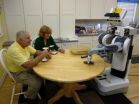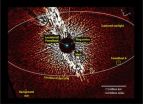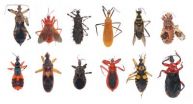(Press-News.org) HERSHEY, Pa. -- The zebrafish is a potential tool for testing one class of unique individual genetic differences found in humans, and may yield information helpful for the emerging field of personalized medicine, according to a team led by Penn State College of Medicine scientists. The differences, or mutations, in question create minor changes in amino acids -- the building blocks of DNA -- from person to person. Zebrafish can be used as a model to understand what biological effects result from these genetic mutations.
Personalized medicine uses modern technology and tools to find biological and genetic differences in individuals so that treatment is more effectively delivered.
"A major challenge of personalized medicine is the lack of a standard way to define the importance of each of the many unique mutations found in an individual's genetic code," said Keith Cheng, M.D., Ph.D., professor of pathology and lead researcher. "Approaches are particularly needed to experimentally determine what differences these mutations make. It is difficult to distinguish the effects of a single amino acid change caused by those changes in our DNA."
The zebrafish is a good choice because of its similarity to humans as a vertebrate, its transparency as an embryo and the powerful genetic tools available in this model organism.
The Cheng lab's approach is like testing small damages in car parts, one at a time. For example, a "mutant" car headlight is known not to work when a certain connector is missing. Taking a normally functioning connector out of a working headlight and replacing it with a connector damaged in a specific way -- a cracked wire casing or a corroded wire connector, for example -- can show whether the damage matters. If the light works, then that mutation makes no difference on the function of the headlight. If the light does not work, the mutation has an effect.
Postdoctoral fellow Zurab Tsetskhladze, who performed the zebrafish experiments, tested this method with two genes that affect skin color. He started with an equivalent of the broken car part: mutant zebrafish with lighter pigment cells. First, Tsetskhladze confirmed that by injecting normal messenger RNA (ribonucleic acid) into the mutant zebrafish, the lighter pigment cells become "cured" -- or darker --like those of a normal zebrafish. Messenger RNA makes the cells produce the protein the scientists want to study.
Tsetskhladze was then able to test RNA with only one "human" mutation to see if cure was still possible. Cure suggests that the mutation does not matter. If cure is prevented by the mutation, the conclusion is that the protein's function is affected by the amino acid difference being tested.
Cheng's lab works with zebrafish to study genetic differences that contribute to human skin color. Scientists want to determine the role these differences play in the development of skin cancer, and to find ways to better protect people from cancer.
In the current study, two of the amino acid differences that Cheng has shown in prior studies to contribute to light skin color in humans prevented the zebrafish color from darkening. A third amino acid difference that is common in Eastern Asians was of unknown effect. The researchers found that the change made no difference in function in zebrafish. This finding matched the findings of K.C. Ang, postdoctoral fellow, who found no effect of the tested change on the skin color of East Asians.
To see if this approach might be used in other ways, Stephen Wentzel, graduate student, Penn State College of Medicine, looked at mutations in the four genes known to contribute to albinism, which lightens the color of skin, eyes and hair, and is associated with any one of more than 250 known single amino acid differences. He found that at least 210 of these are theoretically testable in the zebrafish. This new test may help scientists to determine which mutations can be ignored and which may need action – such as a change in life habit.
"This approach may potentially be extended to other biological functions and may therefore be useful in personalized medicine," Cheng said.
###
The researchers published their findings in PLoS ONE.
Other researchers are Khai C. Ang, Steven M. Wentzel and Katherine P. Reid, all of Jake Gittlen Cancer Research Foundation, Division of Experimental Pathology, Penn State College of Medicine; Victor A. Canfield, Department of Pharmacology, Penn State College of Medicine; Arthur S. Berg, Department of Public Health Sciences, and Stephen L. Johnson, Department of Genetics, Washington University Medical School; and Koichi Kawakami, Division of Molecular and Developmental Biology, National Institute of Genetics, Japan.
This work was funded by a grant from the National Institutes of Health.
Individual gene differences can be tested in zebrafish
2012-10-26
ELSE PRESS RELEASES FROM THIS DATE:
Monster galaxy may have been stirred up by black-hole mischief
2012-10-26
Astronomers using the NASA/ESA Hubble Space Telescope have obtained a remarkable new view of a whopper of an elliptical galaxy, with a core bigger than any seen before. There are two intriguing explanations for the puffed up core, both related to the action of one or more black holes, and the researchers have not yet been able to determine which is correct.
Spanning a little over one million light-years, the galaxy is about ten times the diameter of the Milky Way galaxy. The bloated galaxy is a member of an unusual class of galaxies with an unusually diffuse core filled ...
Exercise boosts satisfaction with life, researchers find
2012-10-26
UNIVERSITY PARK, Pa. -- Had a bad day? Extending your normal exercise routine by a few minutes may be the solution, according to Penn State researchers, who found that people's satisfaction with life was higher on days when they exercised more than usual.
"We found that people's satisfaction with life was directly impacted by their daily physical activity," said Jaclyn Maher, graduate student in kinesiology. "The findings reinforce the idea that physical activity is a health behavior with important consequences for daily well-being and should be considered when developing ...
Robots in the home: Will older adults roll out the welcome mat?
2012-10-26
Robots have the potential to help older adults with daily activities that can become more challenging with age. But are people willing to use and accept the new technology? A study by the Georgia Institute of Technology indicates the answer is yes, unless the tasks involve personal care or social activities.
After showing adults (ages 65 to 93 years) a video of a robot's capabilities, researchers interviewed them about their willingness for assistance with 48 common household tasks. Participants generally preferred robotic help over human help for chores such as cleaning ...
New genes discovered for adult BMI levels
2012-10-26
A large international study has identified three new gene variants associated with body mass index (BMI) levels in adults. The scientific consortium, numbering approximately 200 researchers, performed a meta-analysis of 46 studies, covering gene data from nearly 109,000 adults, spanning four ethnic groups.
In discovering intriguing links to lipid-related diseases, type 2 diabetes and other disorders, the IBC 50K SNP Array BMI Consortium's study may provide fundamental insights into the biology of adult obesity. Scientists from the Center for Applied Genomics at The Children's ...
Academia should fulfill social contract by supporting bioscience startups, case study says
2012-10-26
Universities not only provide the ideal petri dish for cultivating bioscience with commercial potential, but have a moral obligation to do so, given the opportunity to translate public funding into health and jobs, according to a new case study by UCSF researchers.
In an analysis published Oct. 24, 2012 in Science Translational Medicine, researchers at the California Institute for Quantitative Biosciences (QB3) assessed the impact of the institute's efforts over the past eight years in supporting entrepreneurs on the three UC campuses in which it operates: UCSF, UC Berkeley ...
Scientists deepen genetic understanding of MS
2012-10-26
Five scientists, including two from Simon Fraser University, have discovered that 30 per cent of our likelihood of developing Multiple Sclerosis (MS) can be explained by 475,806 genetic variants in our genome. Genome-wide Association Studies (GWAS) commonly screen these variants, looking for genetic links to diseases.
Corey Watson, a recent SFU doctoral graduate in biology, his thesis supervisor SFU biologist Felix Breden and three scientists in the United Kingdom have just had their findings published online in Scientific Reports. It's a sub-publication of the journal ...
Sharing space:
2012-10-26
A new University of Michigan study shows that when researchers share a building, and especially a floor, the likelihood of forming new collaborations and obtaining funding increases dramatically.
The findings have wide relevance to corporations, as well.
"Our analyses clearly show that there are benefits to co-location," said Jason Owen-Smith, an associate professor of sociology and organizational studies.
Researchers who occupy the same building are 33 percent more likely to form new collaborations than researchers who occupy different buildings, and scientists who ...
New study brings a doubted exoplanet 'back from the dead'
2012-10-26
A second look at data from NASA's Hubble Space Telescope is reanimating the claim that the nearby star Fomalhaut hosts a massive exoplanet. The study suggests that the planet, named Fomalhaut b, is a rare and possibly unique object that is completely shrouded by dust.
"Although our results seriously challenge the original discovery paper, they do so in a way that actually makes the object's interpretation much cleaner and leaves intact the core conclusion, that Fomalhaut b is indeed a massive planet," said Thayne Currie, an astronomer formerly at NASA's Goddard Space ...
NASA spacecraft sees huge burp at Saturn after large storm
2012-10-26
NASA's Cassini spacecraft has tracked the aftermath of a rare massive storm on Saturn. Data reveal record-setting disturbances in the planet's upper atmosphere long after the visible signs of the storm abated, in addition to an indication the storm was more forceful than scientists previously thought.
Data from Cassini's composite infrared spectrometer (CIRS) instrument revealed the storm's powerful discharge sent the temperature in Saturn's stratosphere soaring 150 degrees Fahrenheit (83 kelvins) above normal. At the same time, researchers at NASA's Goddard Space Flight ...
A clearer picture of how assassin bugs evolved
2012-10-26
RIVERSIDE, Calif. — Assassin bugs, so named because these insects lie in ambush for prey that they attack with speed and precision, are found all over the world. Nearly 140 species of these bugs are blood-sucking; because they can bite humans around the mouth, they are also called kissing bugs. All kissing bugs can spread Chagas disease, a neglected tropical disease that imposes an economic burden on society.
Surprising, then, that scientists' understanding of the evolutionary history of assassin bugs is riddled with difficulty. The data are incomplete. Fossils, which ...




